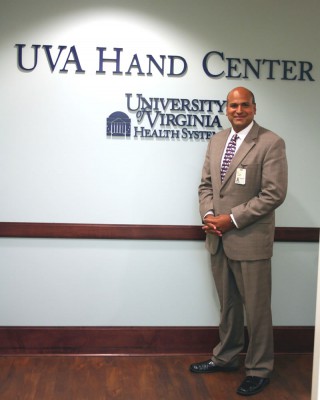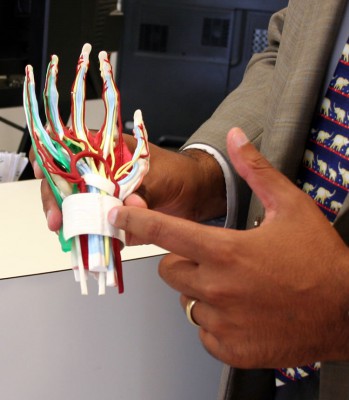The place is lovely. With a flat-screen TV, stylish yet comfortable chairs and gorgeous art on the walls, the UVA Hand Center lobby feels more like a contemporary living room than a waiting room.
When I meet Bobby Chhabra, MD, the co-director of the center, he explains the origins of the welcoming atmosphere. “This was my dream,” he says. “It took over 10 years to build. I helped design the floor plan, picked the colors on the walls. It’s a wonderful place. ”

He’s got good reason to be proud. As he shows me around the bright patient exam rooms, the sunny offices, the smiling staff, it’s clear he’s achieved something special.
His goal, he says, was and is to create “an environment that is patient-friendly; patient care is the most important thing to us, and we want each patient to feel that they’re the most important person in the clinic that day.”
A One-Stop Shop
Of course, the dream was not just about the look and feel of the physical building. Chhabra and his partners wanted to create a place providing convenient and comprehensive treatment not available anywhere else in the area.
This “one-stop shop,” includes:
- Casting
- Occupational therapists
- X-rays
- MRI
- CT scans
- Labs
- EKG
- Pre-op evaluations
“Everything you need is here,” Chhabra smiles. “Any problem in the arm? We take care of it.”
That is, the Hand Center treats issues with hand, wrist, elbow; tendon injuries, nerves, soft tissue, tumors, sports injuries, vascular problems.
Expertise in the Extreme: Dr. Chhabra & Co
But why go to a specialist for your hand?
There are the extreme cases, of course.
Chhabra describes working on infants just months old born with congenital hand differences – with webbing between fingers, without a thumb, or nonfunctioning thumbs, club hands or trigger thumb.
Then there are the accidents. Chhabra has seen it all, it seems – from nerves severed by knives to fingers amputated by chainsaws. People who lose between one and five fingers can get prosthetic i-limb digits – motorized fingers that respond to the body’s electric signals – incredible technology available at the Hand Center and very few other places in the region.
When it comes to these complex cases and severe trauma, the staff at the Hand Center offers uniquely specific expertise. Chhabra handpicked many of the surgeons, nurses and therapists himself.
“We have six of the highest trained individuals in the state and in this region,” he states. They include:
- 4 orthopedic-trained surgeons accredited in orthopedic and hand and upper extremity surgery
- 2 plastic-trained surgeons accredited in plastic and hand surgery
- Physician assistants and nurse practitioners with specialty training in hand and upper extremity care
“And,” Chhabra points out, “this is one of the few centers in the state that’s open 24/7 for hand and upper extremity trauma and microsurgery.”
Everyday Pain: Don’t Take it For Granted
But even more routine, run-of-the-mill injuries from overuse or common fractures and sprains benefit from the concentrated expertise available at the Hand Center. “As opposed to a general orthopedic clinic, hand, wrist and elbow surgery is what we do, all day long,” Chhabra says.
That kind of experience can be critical.
“No one understands how important the hands are until you injure yourself,” says Chhabra. “You take your hands for granted, then you get injured and can’t button your shirt, brush your hair, feed yourself, put on your earrings.”
For these kinds of situations, it’s not just about surgical expertise but the “one-stop shop” approach that makes all the difference.
“The hand, elbow and wrist are very complex, a lot of structures that need to work well in unison. That’s why we provide occupational therapy, and why the surgeons and therapists here work closely together. Hand surgery is important, but therapy is crucial. If there’s any issue, we’re in the same clinic, so we communicate and work on the problem right away.”
So whether treatment involves surgery or not, Chhabra explains, “We have the support to make sure we give you the best approach and the most optimal outcome.”

Carpal Tunnel
When it comes to the most common types of hand-related problems, people can benefit from getting treatment sooner rather than later.
One of those common ailments is carpal tunnel.
Something I didn’t know about this syndrome: It can get so bad that even surgery can’t fix it. Chhabra describes the tunnel in the arm as like a garden hose: “Step on it long enough, no water can flow, and the grass and flowers begin to die.” In this analogy, stepping on the hose equates to aggravating the nerve in your arm through repetitive behaviors — kinking your hands and arms while sleeping in the fetal position, for instance.
Symptoms of carpal tunnel often begin at night but progress to the day.
Treatments range from splints that prevent bends in the wrist and relieve the compression of the tunnel, to surgery.
Chhabra performs an “endoscopically minimally invasive technique that produces less pain and faster return to work due to a smaller incision.” The surgery divides the ligament housing the nerve so that the nerve has more room – like taking your foot off the garden hose.
If no treatment relieves the nerve compression, the injury can, like a cracked hose, become permanent and lead to irreversible weakness and loss of sensation in the hand.
UPDATE: Dr. Bobby Chhabra
Dr. Chhabra is now director of the UVA Orthopedic Department. Learn more about Dr. Chhabra’s work:
A related but not as commonly known condition, cubital syndrome, develops at the elbow, in the funny bone nerve. Aggravating behaviors in this case include holding a phone to your ear with a flexed arm.
Tennis Elbow
Oddly, Chhabra’s experience with this condition has less to do with people who play tennis and more to do with gardeners, golfers and – surprise – dog-walkers.
Chhabra demonstrates the action of holding dog leashes, extending his arm and imitating the grip of a hand on a leash. His wrist bends awkwardly.
For this condition, nonsurgical therapies and ultrasound treatments can be helpful, but ultimately surgery may be necessary. Chhabra says, the people who get tennis elbow can be “the most difficult person to treat. They don’t want to stop gardening, playing golf or walking dogs, the activities that cause the problem.”
Yoga, Sports and Other Risk Factors
The resistance to change or at least vary behaviors is probably the biggest challenge to healing hand and arm injuries.
Would this apply to yoga? I wonder. Yoga, I know from personal practice, is all about repetition.
Chhabra nods. “I see a lot of yoga injuries; I know all the studios in town,” he says. “Wrist problems are rampant in yoga – downward-facing dog puts so much stress on your wrists.”
But gardeners are also known for not wanting to give up their hobby. And certainly, in sports, Chhabra sees “elbow ligament injuries in pitchers, hand and wrist fractures in football, overuse in tennis, rowing, gymnastics, basketball, even elbow cartilage damage in Little Leaguers.” When working with sports teams, including the UVA football team and the UVA women’s rowing team, Chhabra’s role is to “find a way to allow athletes to participate in the things they like to do while making sure they don’t hurt themselves long-term.”
He definitely encourages young athletes to avoid doing one sport year-round. He explains that a young person still growing while putting a lot of stress on bones and joints can result in abnormal growth in their growth plates, which help bones to grow.
Pregnancy, Diabetes, Desks and Texts
Other risk factors Chhabra highlights surprise me. They include:
- Pregnancy—he sees quite a few women who develop carpal tunnel syndrome in their third trimester, which often resolves after delivery. Often non-operative treatment measures are needed.
- Diabetes—returning to the garden hose analogy, Chhabra explains that this health problem can create holes up and down the hose, cause degeneration of nerves over time and add to muscle weakness and sensory problems.
Of course, everyone knows that sitting at a desk all day and typing poses all kinds of risks to the hand and arm. Chhabra’s advice: Take breaks and stretch. And “look at your work station, make modifications so you are more comfortable at work.”
When I ask if using touch screens proves less damaging than typing, he says, “Possibly; we really don’t know. Technologies keep getting developed to avoid injuries, but then we see new conditions developing.”
The topic of technology brings up a condition I had definitely never heard of. “Along with tennis elbow and trigger finger, I’ve actually suffered from BlackBerry thumb,” Chhabra says. Along with texting, Chhabra’s seen damage from overuse of iPhones, video games, even playing with a Wii. “They do cause some stress along your tendons and joints.”
Do you suffer from recurring pain in your hand, wrist, elbow, arm?
If so, visit the Hand Center to make sure you take care of the issue before it becomes chronic and untreatable.
Do you have questions for Dr. Chhabra? What’s your habit that causes recurring pain? Let us know in the comments below.
I am writing a research paper about hand injuries with Iphones and I was wondering if you can give me any more info about these injuries.
Thanks